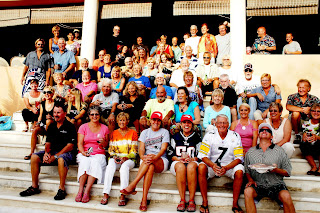 With the slight lift of her lip, the tan and white dog sneered at the bowl of dog food placed before her, “Is this the best you can do? Dog Food?” She flicked her tail and trotted out of the gate, turning to stare commandingly back at the white male dog. “Are you coming?”
With the slight lift of her lip, the tan and white dog sneered at the bowl of dog food placed before her, “Is this the best you can do? Dog Food?” She flicked her tail and trotted out of the gate, turning to stare commandingly back at the white male dog. “Are you coming?” He sighed, looking in dismay at a dish of half-eaten food, hoping to finish it after he had placated Her Highness.
Missy and Odd, or whatever name you know them by, have been living on a strip of the beach across from the Bachilleres school for most of their lives. Missy(a name we gave her due to her condescending attitude) was originally part of a five-dog pack.
Out of necessity, Missy has perfected her mooching act. She sidles up to a new prospect, with her adorable Border-Collie-type ears perked up and the tip of her tail softly thumping: “Aren’t I the cutest thing you have ever seen in your life?”
Missy and Odd, or whatever name you know them by, have been living on a strip of the beach across from the Bachilleres school for most of their lives. Missy(a name we gave her due to her condescending attitude) was originally part of a five-dog pack.
They mooched at the vacation
houses that were being built in the area between what is now the Mango Café and the Bachilleres College. Delfino
remembers spaying her before he started to use ear tattoos, so that would make
her currently around ten years old. Two
or three of the other dogs in the pack were eventually adopted by Americans. That left Missy and her new friend, whom we call Odd, on
the beach scavenging for their survival.
Odd
is very distinctive looking. He has one
blue eye and one brown eye. A friend of
mine suggested we name him Od-eye-see. Due to laziness on my part, the name has now been shortened to just plain
Odd. We have been told that Odd was
originally owned by a man who had a pack of fighting dogs, and Odd wouldn’t fight, so he was chased away
from the house. We think he is around
seven years old, but that’s just a guess.
Out of necessity, Missy has perfected her mooching act. She sidles up to a new prospect, with her adorable Border-Collie-type ears perked up and the tip of her tail softly thumping: “Aren’t I the cutest thing you have ever seen in your life?”
The reaction is predictable. Out comes the food: scraps of meat, pieces of
cheese, anything a dog might eat. If she
is hungry or if the offerings are up to her standards, she will eat. Otherwise, the next act in her repertoire
includes ears tucked in, shoulders slumped and a very sad look in her eyes. However, if Missy and Odd are treated to a tasty bit of leftovers, she will perform her Happy Dance, akin to a Dog Salsa. In the winter months, they are pampered, for a
week or two, and sometimes for a month or six weeks, by various sets of
returning visitors. The dogs have
learned to recognize their favourites, quickly re-establishing the friendship
until the vacation time is over once again.
As servants to two demanding cats, we had no intention of feeding beach dogs, especially after watching how many sets of vacationers fussed over them.
As servants to two demanding cats, we had no intention of feeding beach dogs, especially after watching how many sets of vacationers fussed over them.
And then came the summer of 2009, with the
Swine Flu scare, and few, if any, tourists on the island. The two dogs were starving. We couldn’t stand it and started to feed
them, offering them food and fresh water twice a day.

I eventually asked our contractor, Patricio Yam Dzul, to build a shelter for the dogs in our carport.

I eventually asked our contractor, Patricio Yam Dzul, to build a shelter for the dogs in our carport.
That caused a lot of giggles amongst the crew. “A dog house. Seriously?”
We now have a nice
cozy place, complete with a padded bed from Costco, for Odd and Missy to curl up on
during the inclement weather.
They have learned to adapt. When
they see an old friend, they disappear in a puff of dog hair, running flat-out
down the beach - greeting their long lost pals. We are just their backup plan.

We are now well-trained gringos – feeding two beach dogs as well as our two cats, a dozen or so free-roaming iguanas and about two hundred hermit crabs.
Food. Water. A safe place to sleep. Vaccinations. Monthly flea and
tick treatments. Medications for various
illnesses and injuries are provided when required. You would think that these two dogs would be steadfast and loyal. No!
They have been
loved and left many times during their lives.
 |
| Grandsons and a friend with Odd the Dog |

Lynda & Lawrie




%20Instagram%20%231.jpg)























